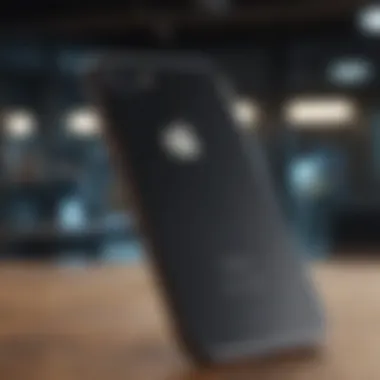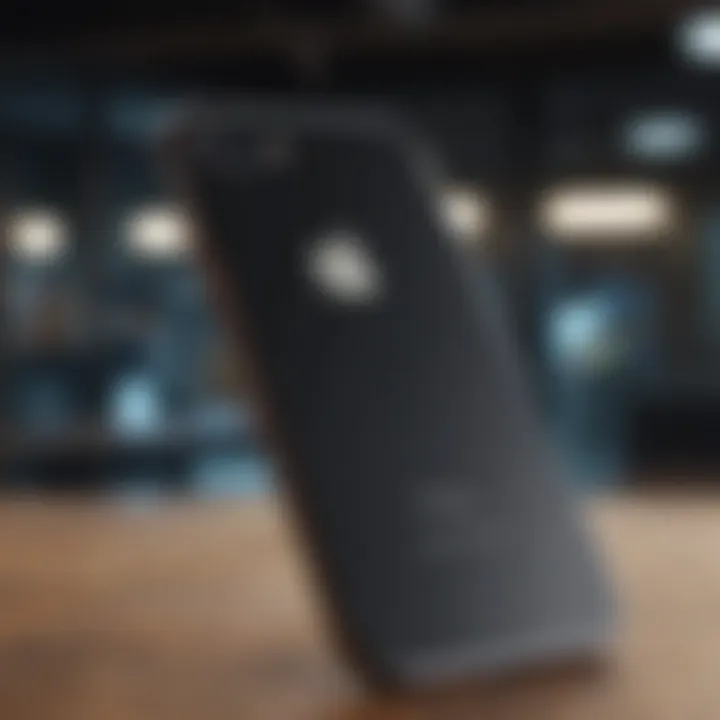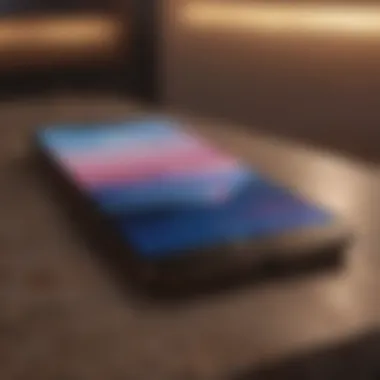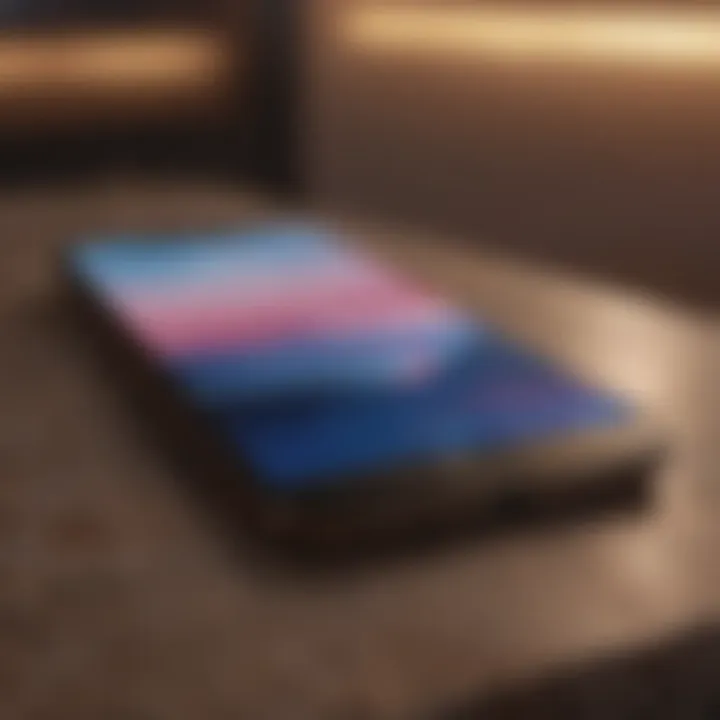Understanding the Cost of an iPhone 8: A Comprehensive Guide


Intro
The iPhone 8, released by Apple in 2017, marked a distinctive transition in mobile technology. As a comprehensive guide to its cost, understanding the price points associated with this model is essential for prospective buyers. This article will help you navigate the various factors that influence the cost of an iPhone 8.
The cost can greatly fluctuate due to multiple variables. These include its current market price, the condition of the device, and the different retail platforms available. Also, analyzing the longevity of the iPhone 8 and user experience offers significant insights into overall value.
In this discussion, we will dive deep into each aspect that contributes to the pricing landscape of the iPhone 8. This will guide you to make informed purchasing decisions while considering the evolving trends in technology.
Overview of Financial Product
Definition
An iPhone 8 is a smartphone developed by Apple that integrates advanced features such as a powerful processor and an excellent camera. It offers a unique blend of functionality, design, and reliability.
Key Features
- Design: The iPhone 8 presents a durable glass exterior with a metallic frame.
- Display: It features a 4.7-inch Retina HD display.
- Camera: The device boasts a 12MP rear camera with advanced capabilities.
- Processor: It is powered by the A11 Bionic chip, supporting various applications seamlessly.
- Storage Options: The iPhone 8 comes in 64GB and 256GB configurations.
Purpose and Benefits
Owning an iPhone 8 provides access to various applications and services. Users gain a reliable device for communication, entertainment, and productivity. Additionally, its integration within the Apple ecosystem enhances user experience due to compatibility with different Apple products.
Factors Affecting Cost
Market Price
The market price for an iPhone 8 can change over time. New models' releases usually lead to a decrease in older models' prices. Current prices can be fetched from several platforms, including:
- Apple’s official website
- Amazon
- eBay
- Secondary marketplaces
Condition Variations
The condition of the iPhone 8 can greatly influence its price. Devices can be:
- New: Typically sold at higher prices.
- Used: Prices vary based on wear and tear.
- Refurbished: These often offer a balance of quality and price.
“Understanding the condition is crucial when assessing the price.”
Differences Across Purchasing Platforms
Different platforms yield various pricing structures. For example, buying directly from Apple often provides warranties and services that might not be available from third-party sellers.
Implications of Ownership
Financial Planning
Acquiring an iPhone 8 requires careful financial planning. Understanding the total cost of ownership aids in budget management. It will help you weigh the benefits against your current financial situation.
Device Longevity
The longevity of the iPhone 8 should be considered. While it can perform well for several years, software support and updates impact its usability over time.
User Experience
User satisfaction can differ based on personal preferences and needs. An informed understanding of its features can lead to better overall experience.
Ending
In summary, the cost of an iPhone 8 is influenced by various factors such as market pricing, device condition, and purchasing platforms. By understanding these elements, users can navigate the complex pricing landscape of the iPhone 8. This knowledge empowers potential buyers, allowing them to make well-informed choices in a tech-driven world.


Preface to iPhone Pricing
The pricing of the iPhone 8 serves as a crucial aspect to understand for both potential buyers and tech enthusiasts alike. As Apple continues to release newer models, the iPhone 8 remains relevant due to its balanced features and established performance. This section specifically delves into the factors contributing to its pricing.
Firstly, it is important to recognize the competitive landscape of mobile devices. Understanding how the iPhone 8 fits within this context can greatly influence a purchasing decision. Many consumers appreciate knowing the market price range as it enables better budgeting and financial planning.
The depreciation of technology is another aspect to consider. For users seeking a compelling device without breaking the bank, the iPhone 8 offers an attractive option in contrast to the latest iterations. By being informed about its pricing trends, buyers can assess their choices wisely.
Moreover, this section provides insight into various elements affecting pricing. From device condition to storage capacity, each influence alters how much one may expect to pay.
In summary, grasping the nuances of iPhone 8 pricing not only informs prospective users about the financial implications but also elucidates the broader market dynamics. With this knowledge, readers can navigate their purchasing decisions in a tech-driven environment.
Current Market Price
The current market price of the iPhone 8 plays a critical role in determining how potential buyers make their purchasing decisions. Understanding this price helps consumers gauge whether they are making a smart investment. The iPhone 8's pricing is influenced by several factors, including its condition, storage capacity, and market demand.
Knowing the current price can also assist buyers in comparing it with other models. Sometimes, users might find that for a slight increase in budget, newer models offer upgraded features. Therefore, familiarizing oneself with the iPhone 8's pricing is essential for informed decision-making.
Retail vs.
Resale Prices
When evaluating the cost of an iPhone 8, it is important to distinguish between retail and resale prices. Retail prices are typically set by authorized retailers and reflect the brand's established pricing strategy. For example, Apple’s website usually lists the iPhone 8 for a standard price when new. Resale prices, on the other hand, can vary greatly.
Factors influencing resale prices include:
- Condition: The better the condition, the higher the resale value usually is.
- Storage Capacity: Higher storage options generally command higher prices.
- Market Perception: If demand is high, resale prices may increase.
Some may consider purchasing from platforms like eBay or Craigslist for better deals. However, buyers should be cautious of potential risks associated with purchasing second-hand devices. It is wise to ensure that the phone is fully functional and free from significant damage before completing a purchase.
Influence of Supply and Demand
Supply and demand heavily impact the iPhone 8's market price. When new models come out, the demand for older models may decrease, leading to lower prices. However, the iPhone 8 is still in demand due to its balance of performance and affordability.
Several aspects characterize the supply-demand dynamic:
- New Releases: When Apple releases newer models, older models like the iPhone 8 might see price drops due to less perceived value.
- Technical Support: If Apple maintains support for the iPhone 8 through software updates, demand may remain stable and even foster a collector's market.
- Market Trends: Users looking for budget options might consistently seek older models, creating sustained demand.
In summary, keeping an eye on the supply and demand trends is essential for potential buyers. This helps to time purchases for optimal pricing, ensuring they get the best value possible.
Factors Affecting Pricing
The price of an iPhone 8 is not solely dictated by its brand reputation or the basic features it offers. Various factors contribute to the overall pricing that buyers should consider before making a purchase. Understanding these elements leads to a more informed decision-making process. By analyzing the different conditions of the device, storage capacity, and market trends, one can better comprehend the dynamics of iPhone 8 pricing.
Condition of the Device
New Devices
Buying a new iPhone 8 guarantees you the latest technology and full warranty. New devices come directly from Apple or authorized retailers, ensuring authenticity. The primary characteristic here is that these phones are untouched and come with no prior user history. This is a strong selling point, especially for buyers who want stability and peace of mind. However, the downside is the initial high cost, which may not align with everyone's budget. The upfront investment can be significant, but many find the security of a new device worth it.
Refurbished Options
Refurbished iPhone 8 models are often a more economical choice. These devices have typically been returned to the manufacturer, repaired and tested to meet quality standards. The key feature of refurbished phones is their reduced price compared to new ones. This makes them appealing to cost-conscious buyers. However, while refurbished options can provide good value, they may lack the same warranty coverage as new devices, leading to potential repair costs. The careful selection of a reputable retailer is crucial when considering this option, ensuring the quality meets expectations.
Used Devices
Used devices present another viable option, often at the lowest price point. Buyers can find great deals on platforms like eBay or local classifieds. The main characteristic is that these devices have had previous owners, which inevitably raises questions about their condition and longevity. The appeal lies in significant savings but comes with risks, such as potential functionality issues. There’s usually no guarantee, so buyers must perform due diligence. Inspecting the device thoroughly and verifying its condition are necessary steps to take before purchase.
Storage Capacity Variations
The storage capacity of an iPhone 8 dramatically influences its price. The base model typically offers 64GB, while variants may reach up to 256GB. Larger storage options can command higher prices, which is a critical consideration for users who require ample space for apps, photos, and media. Generally, buyers must evaluate their storage needs carefully. An average user might find 64GB sufficient, while someone heavily using the device for content creation or storage might prefer the larger capacity. The trade-off often involves balancing cost against the potential necessity of storage space, making it a key factor in pricing.


Market Trends and Product Life Cycle
The iPhone's position in the product life cycle also influences pricing. As newer models are released, the iPhone 8 might experience price drops, especially in the secondary market. Understanding market trends, such as consumer preferences towards newer technology, can assist buyers in timing their purchases effectively. Price fluctuation happens often as demand shifts with new releases, so one must watch these trends closely. Keeping up with tech news and announcements can provide clues on when to buy, maximizing value for money.
Comparative Pricing Analysis
Understanding pricing for the iPhone 8 requires analyzing various aspects of its market. Comparative Pricing Analysis plays a crucial role in this examination, allowing consumers to assess the true value of their purchase. By evaluating different pricing models, consumers can make more informed decisions while avoiding potential pitfalls. This section covers various considerations that are essential for recognizing how price variation affects the overall cost.
Carrier Pricing vs.
Unlocked Models
When looking to purchase an iPhone 8, one of the fundamental choices will be between carrier pricing and unlocked models. Carrier pricing often tends to be lower at face value. This option allows customers to buy a device at a subsidized price in exchange for committing to a specific carrier with a set contract term. While this seems financially enticing, it can come with specific obligations and restrictions.
On the other hand, unlocked models provide significant flexibility. Buyers are free to choose or change their carrier, without being tied to any contracts. This choice often translates into a higher initial cost, yet it may offer savings in the long run, especially for those who travel or switch carriers frequently. It is important to consider long-term usage patterns before making a decision.
Price Differentiation by Retailer
The price of the iPhone 8 can also vary across retailers. Authorized sellers, like the Apple Store, may have the highest sticker price, reflecting their branding and support services. However, other retailers, both online and in physical locations, may offer competitive pricing, particularly during sales events.
The variation can be significant between different platforms. For instance, online marketplaces like eBay and Amazon often feature used or refurbished options at reduced prices. Yet it is vital to verify the credibility of the seller and the condition of the device.
This comparative analysis allows buyers to understand where they are getting the best value. Consumers should keep an eye on ongoing promotions or bundled offers that can enhance the overall savings on the purchase. Different retailers may also provide various payment plans and financing options, adding another layer to the decision-making process.
Understanding the nuances between carrier and unlocked pricing, along with the different retailers, can substantially affect your financial planning for owning an iPhone 8.
Ownership Costs Beyond Purchase Price
Owning an iPhone 8 encompasses much more than the initial purchasing price. Understanding ownership costs is crucial. These costs include aspects like insurance, repair, and the device's longevity. Each factor plays a significant role in the overall financial consideration when one decides to purchase an iPhone 8. Recognizing these costs helps in making a well-informed decision.
Insurance and Protection Plans
When you buy an iPhone 8, considering insurance and protection plans is wise. These plans offer financial security against accidents, theft, and damage. While they add an extra monthly expense, they can save you significant money in case something happens to your device. For instance, AppleCare+ covers accidental damage at a reduced service fee, which can be much lower than repairs without a plan.
Factors to consider:
- Cost of premiums: Monthly or annual payments that can add up.
- Deductibles: Amount you pay out-of-pocket per claim.
- Coverage: What is included and excluded in your plan.
Ultimately, the decision to acquire insurance should align with your lifestyle and how prone you are to accidents. Regular users may find insurance beneficial, while others rarely encounter issues with devices.
Repair Costs and Maintenance
Repair costs are another significant aspect of iPhone ownership. If the device encounters issues outside warranty, repairs can be expensive. Apple has a reputation for high repair fees, especially for screens and components. Knowing typical costs can help you budget effectively.
Some points to consider include:
- Common repairs: Screen replacements, battery issues, and water damage are frequent problems.
- DIY repairs: Consider if you are handy enough to attempt minor repairs yourself.
- Third-party repair shops: Sometimes, they offer competitive pricing compared to Apple's service.
Additionally, regular maintenance can prolong the device’s life. Keeping software updated and avoiding harmful physical environments contributes to device integrity.
Longevity and Resale Value
Finally, considering the longevity and resale value of an iPhone 8 is essential for a complete ownership cost analysis. iPhones generally retain their value better than other brands. However, the resale value will be affected by the device’s condition and market demand at the time of sale.
Key points include:
- Condition assessment: Regular cleanings and careful usage increase resale appeal.
- Timing the sale: Selling before a new model is released can fetch a higher price.
- Market trends: Staying current with tech news helps gauge best times to sell.
Where to Buy an iPhone


Finding the right place to purchase an iPhone 8 is critical for making a wise investment. The decision impacts not just the initial cost but also the overall experience of ownership. Each purchasing option comes with its own set of advantages and disadvantages, depending on consumer preferences. Understanding where to buy can lead to smarter choices that align with individual needs and budgets.
Authorized Retailers
Authorized retailers play a significant role in the purchase decision. Buying from these venues often ensures that consumers receive legitimate devices accompanied by warranties. Retailers such as Best Buy and Apple Store can provide the latest information on promotions and new arrivals. An advantage of shopping at authorized retailers includes readily available customer service and instant support for any issues that may arise.
When looking to buy from authorized retailers, consider the following:
- Authenticity: Purchase confirmation of the device’s authenticity.
- Warranties: Take advantage of manufacturer warranties that can save costs in case of repairs.
- Bundles: Some retailers offer bundled deals that include accessories or plans that might add value.
Online Marketplaces
The digital age has revolutionized how consumers approach purchasing technology. Platforms like Amazon and eBay offer a wide range of options for buying an iPhone 8. One major benefit of online shopping is the ability to compare prices and specifications easily across various listings.
However, caution is required when buying online:
- Seller Ratings: Check seller ratings and reviews to ensure reliability.
- Return Policies: Be aware of the return policies as they can vary greatly, affecting potential refunds or exchanges.
- Pricing Fluctuations: Prices on online platforms may fluctuate based on demand, so it is wise to monitor listings over time.
Refurbished and Second-Hand Options
The market for refurbished and second-hand devices has grown rapidly. These alternatives can save consumers a significant amount of money. Websites like Gazelle and Swappa often feature phones that have been inspected and are backed by limited warranties. This option serves budget-conscious buyers who seek affordability without sacrificing quality.
Potential benefits of this approach include:
- Cost Savings: A refurbished iPhone 8 may cost substantially less than a new one.
- Eco-Friendly: Purchasing used devices can contribute to sustainability efforts by reducing electronic waste.
Overall, the choice of where to buy an iPhone 8 should align with personal preferences, budget restraints, and desired convenience. By evaluating authorized retailers, online marketplaces, and refurbished options, consumers can make informed decisions that fit their lifestyle.
Future of iPhone Pricing
The future pricing of the iPhone 8 is a significant topic within the context of this article, as it allows consumers to grasp how the value of their investment might change over time. An understanding of potential depreciation trends and the impact of upcoming Apple product releases can guide buyers in making smart purchasing decisions. Knowledge of these elements can inform budget planning and device longevity considerations.
Potential Depreciation Trends
Depreciation is an inevitable aspect of technology. The iPhone 8, while a solid device, faces depreciation as newer models enter the market. As time passes, the demand for older phones usually decreases, which can lead to lower resale values. Users purchasing the iPhone 8 today might see a significant difference in its price point compared to where it stands in a few years.
Factors influencing depreciation include:
- Technological advancements: Newer models with upgraded features often overshadow older ones, lowering their appeal.
- Market saturation: An increase in available devices can further dilute interest in past models.
- Consumer preference: Trends can also pivot rapidly; people might favor newer technologies over established models like the iPhone 8.
It is wise for potential buyers to consider these depreciation trends, not just for their budgeting but also for understanding how the device’s value may diminish over time.
Impact of New Releases from Apple
The release of new Apple devices significantly influences the pricing landscape for older models. Apple typically rolls out new iPhone models each year. With each new launch, previous generations, like the iPhone 8, may see a drop in demand and subsequently pricing.
When new releases occur, the following effects can typically be observed:
- Immediate price cuts: Retailers and Apple often reduce prices for older iPhones to make way for new inventory.
- Increased used market supply: As consumers upgrade to newer devices, they may sell their older iPhones, which saturates the second-hand market and drives prices down further.
- Consumer behavior shifts: New features and designs entice buyers towards the latest models, making older versions less desirable.
Understanding these dynamics is crucial for anyone looking to buy an iPhone 8. Being aware of how new releases affect pricing can also help in planning for future upgrades or resale.
It’s essential for consumers to weigh the aspects of depreciation and new releases against their need for an iPhone 8, so they can make a sound investment.
Culmination
In summation, the cost of an iPhone 8 encapsulates various elements that go beyond the mere purchase price. Understanding this complex pricing landscape is crucial for potential buyers, as it allows them to make informed choices. A key aspect to consider is the device's condition; new, refurbished, and used options each present different price points and value.
Moreover, ownership costs should not be overlooked. Expenses related to insurance, repairs, and maintenance contribute significantly to the overall financial commitment associated with the device.
The market dynamics also play a pivotal role. Factors such as supply and demand directly influence current pricing models. Additionally, trends related to newer releases from Apple can cause fluctuations in the resale value, which can be strategically considered by buyers.
Lastly, securing the best purchasing options—whether through authorized retailers, online marketplaces, or second-hand outlets—adds another layer of complexity. By factoring in these considerations, consumers will equip themselves with the necessary knowledge to navigate the market effectively.
Ultimately, investing time to understand the costs linked to owning an iPhone 8 pays dividends in both financial management and user experience.
"A deeper understanding of costs leads to better decision-making in technology purchases."



